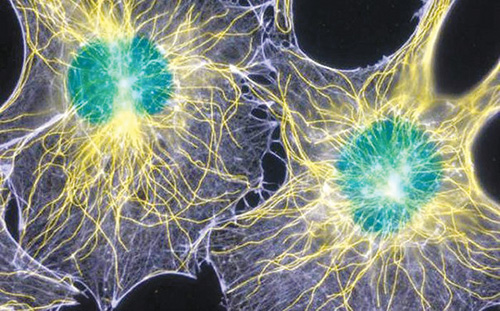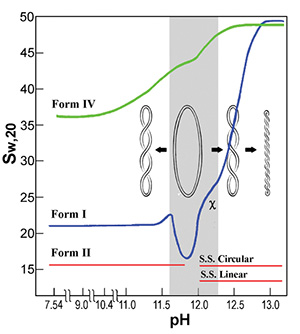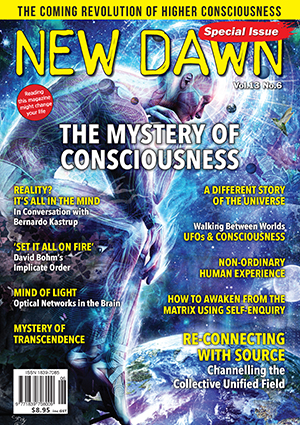Mind of Light: Optical Networks in the Brain (and Beyond)
From New Dawn Special Issue Vol 13 No 6 (Dec 2019)
Modern brain research is conducted under the rather arbitrary assumption that the original emergence of consciousness was likely to have been a lucky accident, a random byproduct of neuronal activity within the brain over millennia of interacting with a challenging external environment.
Based upon this initial assumption, vast sums of research money have been committed in a global effort to map the complex wiring system of billions of neurons throughout the brain. But in recent years this “tracing the door-bell wiring approach” is being challenged as new information urges us to begin to search in a radically new direction to discover how consciousness actually operates within the human body.
A growing number of researchers now believe that we have been looking for consciousness in the wrong place, that we have been so one-pointedly focused upon electrical impulses running along nerve fibres that we have neglected to consider the possibility that consciousness might be found to be the activity of 3-dimensional electromagnetic flux within the brain cavity, rather than in the activity of nerve impulses flowing through neuronal pathways.
New evidence supports the idea that consciousness may be operating through an optical network system using biophotons, light “packets” emitted by living cells, a phenomenon that was first discovered in 1923. More recently, Sergey Mayburov at the Lebedev Institute of Physics in Moscow, measured streams of biophotonic emission within living fish eggs. These streams consisted of short quasiperiodic bursts, which were seen to be remarkably similar to those used to send binary data over a noisy channel.
Within our bodies, such a network of biophotonic information packets could very well operate in a manner similar to our current global information network, which is primarily interconnected through beams of light coursing through fibreglass cables. Of course, such a possibility would not be news to those highly skilled mystics, saints, and ayahuasceros who have described experiencing a “Mind of Light.” Further support for this idea can be found in numerous recent scientific papers such as the neuroscientist Tuszyński’s “Are There Optical Communication Channels in the Brain?”

This article will examine the five considerations listed below which seem to have been persistently neglected in research to date. Taken together, they may provide a synergistic framework for future experiments designed to detect and perhaps interact with an existing “Mind of Light” within each human being.
- Scale (the relationship of bandwidth to wavelength size)
- Signal modulation of electromagnetic waves
- Biophotonic information packets
- Biophotonic communication networks (powered and modulated by DNA supercoiling)
- Spherical harmonics of electromagnetic fields in the cosmos
If the fundamental nature of consciousness could be identified, it is not difficult to imagine the subsequent development of numerous new possibilities for mind-brain interaction. Such a breakthrough could quickly lead to unanticipated new hardware interfaces to consciousness, new devices designed to interact with, amplify, influence, and enhance human consciousness itself.
The Relevance of Scale
Understanding the importance of scale should be a major consideration when searching for consciousness within the human body. Electromagnetic signals interact with physical objects at the same dimensional scale as the wavelength of those frequencies. In physics this phenomenon is called resonance. This is why radio antennas are physically tuned to the exact size of the wavelengths of the radio frequency that will be received and/or transmitted through the antenna.
Many consciousness researchers claim that consciousness must somehow be associated with Alpha waves which have a frequency of 8Hz. However, the length of an 8Hz wave is 23,285 miles. This is nowhere near the size of any structure within human physiology (and of course an 8Hz signal could carry relatively little encoded information). Human consciousness requires much higher frequencies to encode complex information, and higher frequencies imply wavelengths many magnitudes smaller than 23,285 miles. Any search for an electromagnetic basis for consciousness should begin by looking for frequencies that have the same scalar wavelength as physiological structures within the human body.
It is well known that the human body broadcasts electromagnetic energy (as can be seen with night vision goggles). This energy frequency peaks at a wavelength of 10 microns (or 10μm) which is in the infrared range, just below visible light. If this energy is somehow associated with consciousness it should resonate with some structure that is in the 10 micron range. It turns out that this 10μm is the precise physical size of the inner diameter of human blood capillaries, which if laid out end-to-end, would stretch out close to 50,000 miles. Thus, it is quite possible that the human capillary system acts as a waveguide for a network of infrared light energy, carrying a 10 micron electromagnetic data stream throughout the human body. A signal with a wavelength of 10 microns has a frequency of 3×1013 Hz, with a relatively enormous capacity to carry encoded information as compared to the 8Hz Alpha waves.
Another possible physiological candidate for resonant interaction with a system of electromagnetic consciousness would be microtubules, part of the structural cytoskeleton of all human cells, including neurons. Microtubules are hollow structures with inner diameters of approximately 12 nm. Accordingly, microtubules could also act as waveguides, but in this case, for electromagnetic wavelengths of 12 nm (or in scientific notation, 1.2 x 10-8m). Such a wavelength corresponds to a resonant frequency of 2.5×1017 Hz, a frequency that is within the ultraviolet range of the electromagnetic frequency spectrum and has an enormous capacity for encoding information.
Signal Modulation of Electromagnetic Waves
Discerning these frequency bands of electromagnetic consciousness is only the first and perhaps the easiest step in mastering the physics of consciousness. Once located, the information encoded within the dynamics of the electromagnetic frequencies in that band have to be decoded or demodulated. There are innumerable ways to modulate, or encode, information.
Simple “AM radio” varies the amplitude, or strength, of the signal at the frequency. The variation in time matches precisely the same equivalent variations in the frequency of air motion that our human hearing system interprets as “sound.” “FM radio,” however, varies the frequency itself while maintaining a constant amplitude. The frequency changes up and down within a 2 KHz range to match the equivalent 2 KHz range of audio vibrations that can be heard by most humans.
There are many more ways of encoding information via frequencies. Modern digital communication systems are all directly built upon detecting the data “bit,” used as a binary toggle, the “ON/OFF” signal state. This is indeed the basis of all digital encoding of information. Other data modulation schemes can use variable rates of amplitude, frequency, or a combination of the two over a specific period of time.
The greatest challenge to neurophysicists, brain scientists, and those involved in consciousness studies is to determine how nature, specifically within the human brain, is modulating and demodulating information via electromagnetic fields. Just how is thought encoded within these non-linear electromagnetic fields given the three separate domains (five dimensions) of time, space, and frequency?
Photons as Information Packets
At this point we must ask the following question: By what mechanism might electromagnetic information in these high frequency bands operate within the physiology of the brain and throughout the human body (and perhaps even outside of the human body)? Is there any evidence that, in addition to the well-studied molecular chemical communications in human physiological systems, there might very well be some photonic communication network in operation, simultaneously active (but distinct from) the chemical-carrier network?
Contemporary research has discovered that there appears to be a photonic communication network within human physiology. A growing number of experiments have detected the existence of widespread biophotonic radiation within the human body. These results have supported the conjecture that photons may indeed play an important role in the basic functioning of cells.
Photons are the fastest and most robust carriers of information over long distances, as can be seen in the ubiquitous global man-made networks supporting the internet, all of which rely on optical communication channels (typically fibre optic cables routing modulated photons in the infrared range). Photonic communication also offers quantum information processing capabilities with which to support the incredibly high rates of information processing necessary for cognitive operation of the human mind.
Biophotons in Living Creatures
Is there evidence of photon emission in the brain? Recent experiments in several countries have repeatedly detected the existence of biophotons in all living creatures.
All living cells of plants, animals and humans continuously emit biophotons(ultraweak electromagnetic waves) in the optical range of the spectrum, which is associated with their physiological states and can be measured using special equipment. Neural cells also continuously emit biophotons. The intensity of biophotons is in direct correlation with neural activity, cerebral energy metabolism, EEG activity, cerebral blood flow and oxidative processes.
Biophotons were first discovered in Russia in 1923 by Professor Alexander Gurwitsch and were widely researched in Europe and the USA in the 1930s. In 1974 German biophysicist Fritz-Albert Popp was able to demonstrate that their origin lies within DNA. In fact, the emission of biophotons appears to be linked to what is called “DNA supercoiling.”
In studies as early as those by Gurwitsch in the 1920s, researchers have been testing the bio-communication aspects of photonic emission from cells. Gurwitsch put forth the idea that “radiation generates cell division” as early as 1911.
Now if we assume that these biophotons in plants, animals, and humans are participating in an active communication network linking innumerable physiological subsystems into one whole, then information must somehow be modulated and retrieved via these photonic messengers.
What would be required to support a biophotonic communication network? First of all, photonic communication systems within the brain would require optical waveguides to channel the biophotons while protecting them from decoherence (the degradation of their own signal content) due to the myriad of larger wavelength EMF activity (referred to as “static” in radio receivers), external “noise” within the brain beyond each waveguide. Typically, waveguides would likely also function to facilitate routing of biophotons to other systems of the brain/mind.
The biophoton emission rate is about 1 photon per neuron per minute. If one takes such a low rate of biophoton emission and considers the fact that there are about 1011neurons in a human brain, there would still be over a billion photon emissions per second.
In discussing the propagation of electromagnetic fields in brain tissue, Giuseppe Vitiello suggests the following:
In biological systems coherent oscillations of dipoles… would be confined inside filaments or tubes. The electromagnetic field would thus propagate within a network of filaments inside the correlated water medium, provided the strength of the electric disturbances is sufficiently high…. The diameter of the filament in the simplified case of a completely aqueous medium with maximum of polarization may be computed and it turns out to be of the order of 15 nanometers, which is a figure very near to the inner diameter of microtubules…. As a matter of fact, the observed dynamical behavior of the cytoskeleton, with its intricate network, with continuous creation and destruction of branches, and with its movements, is a true puzzle to biochemistry.
Optical Networks in the Brain
A recent study points out the reasonable expectation of an optical communication network within the human mind/brain systems.
With the advantages optical communication provides in terms of precision and speed, it is indeed a wonder why biological evolution would not fully exploit this modality.
The twenty-first century communications network operates through a vast network of fibre optic cables that act as the waveguide for photons connecting our continents. It is interesting to compare the performance of this optical system with the first electrical intercontinental cabling system.
In August 1858 the first message between nations was sent by modulated electrical signals over the new cable, a message from British Queen Victoria to US President James Buchanan. These first messages were exchanged over the newly laid transatlantic cable resting on the floor of the Atlantic Ocean, and though the messages were short in length, they required 17 hours for transmission via Morse code. Due to the many unknowns affecting long range transmission of electrical signals through this underwater cable, it took a full two minutes to transmit even a single character. Over time the technology would improve, but even forty years later the maximum transmission rate over transatlantic cables had only reached 120 words per minute. Yet previously, even a one-way message from her Majesty, Queen Victoria, to President Buchanan would have had to be sent through a combination of steamship courier and land telegraph, taking 12 full days. Thus, the first transatlantic cable was hailed as “the 8th Wonder of the World.”
By contrast, the average two-way internet rate of information transmission in 2017 was 7,200,000 bits (7.2 Megabits) per second. Of course, modern cables are not copper wires but fibre-optic bundles which stream enormous networks of modulated photons. The estimated total length of underwater intercontinental fibre optic cables as of 2014 was a total of 550,000 miles.
In the human body, the total length of capillaries branching out from the blood vessel system is about 50,000 miles, or about one tenth of the current global fibre optic communication network (the internet). The capillary system would thus be a suitable waveguide for channelling photonic information within the 10μm electromagnetic infrared range throughout the human body.
It is interesting to note that the network of photons modulating our internet is powered by carbon dioxide lasers, currently the highest-power continuous wave lasers available. These CO2 lasers produce a beam of photons that resonate within the infrared wavelength band, between 9.4μm and 10.6μm, with the principal wavelength centred on 10μm. Surprisingly (or perhaps not surprisingly?) this is identical to the wavelength of peak radiation that streams throughout the human blood capillary system. The human body produces over two pounds of carbon dioxide each day, and all of this CO2 is distributed in the coursing ionic bloodstream flowing throughout the body in the system of capillaries.
DNA Supercoiling
Electromagnetic radiation occurs when an electric charge spins (“oscillates”) within a specific frequency range. Biophotons radiate electromagnetic energy throughout the spectral range from 180 nm to 1000 nm, covering the ultraviolet, visible and near infrared. The corresponding frequency range is from 3 × 1014 to 1.6 × 1015 Hz. The generation of these photons requires two phases: (1) an energy pumping that builds up the charge of the spinning electron to the excited level, and (2) the emission of a photon with the corresponding loss of charge of the spinning electron. Where might we look to discover the source of biophotonic plasma generation? The answer seems to be in DNA supercoiling (see Figure 1).

DNA rings have been found to be extremely sensitive to variations in pH, the excess or deficit of electrons in surrounding aqueous fluids. Slight changes in pH result in causing these DNA rings to alternately coil and uncoil. In coiling, the rings store up energy from the surrounding ionic electromagnetic environment; when they relax from a coiled state to a circular state, the additional stored energy is released as biophotons. It has been determined that biophoton emission rates are about 1 photon per neuron per minute. Given that there are about 1011 neurons in the human brain, this would equate to over a billion photon emissions per second, more than sufficient to facilitate transmission of a large number of bits of information, and to offer the possibility of an enormous network of quantum entanglement in the resulting swarm photonic plasma. It is quite feasible that these biophotons themselves are modulated in some fashion with information transferred from within the DNA configuration.
Waveguides
It has been speculated that myelinated axons could serve as the waveguides for travelling biophotons within the brain. The widest myelinated axons in the brain have an inside diameter of 10μm, while the narrowest are 0.2μm in diameter. Of course, narrower waveguides channel higher frequencies (and correspondingly can handle higher rates of encoded information transfer).
Kirlian Photography

One final piece of the puzzle in support of electromagnetic field consciousness is the phenomenon of Kirlian photography, first discovered in 1939 by the Russian electrical engineer Semyon Kirlian. It was found that by placing an object on a photographic plate connected to a high-voltage source, a photographic image of previously unsuspected radiation patterns emitted by the object could be produced. This phenomenon has been subsequently called by various names: electrography, electrophotography, corona discharge photography (CDP), bioelectrography, electrophotonic imaging (EPI), and in Russia, Kirlianography. The corona discharge glow at the surface of an object (Figure 2) subjected to a high-voltage electrical field is referred to as a “Kirlian aura” in Russia and Eastern Europe.
In short, there are numerous avenues of exploration open to future researchers in the search for the physics of consciousness. Many of these areas have been largely ignored by neurophysiologists in their race to map the complex neuronal wiring systems of the brain. It is this author’s hope that broader avenues of exploration will eventually result in a true understanding of the physics and dynamics of this amazing phenomenon that is consciousness.
Shelli Joye’s book Developing Supersensible Perception: Knowledge of the Higher Worlds through Entheogens, Prayer, and Nondual Awareness, is available from all good bookstores. The footnotes for this article are published in the print and PDF versions of this magazine.
 Get the issue this article appears in!
Get the issue this article appears in!
© New Dawn Magazine and the respective author.
For our reproduction notice, click here.

 All of our Links: https://linktr.ee/freedomiscallingyou
All of our Links: https://linktr.ee/freedomiscallingyou




 www.newdawnmagazine.com
www.newdawnmagazine.com







